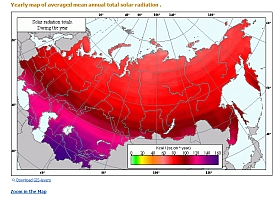A team of researchers from Russia and the U.S. have developed AgroAtlas, an online resource of agricultural and geographic data for Russia and surrounding countries. The publicly available collection, with downloadable tools to analyze the data, is a joint project of Russian universities and institutes, and the USDA’s Agricultural Research Service, with funding from the U.S. State Department.
AgroAtlas shows the geographic distributions of 100 crops; 640 species of crop diseases, pests, and weeds; and 560 wild crop relatives growing in Russia and neighboring countries. The atlas — with versions in Russian and English — also includes 200 maps displaying environmental variables affecting crop production in that part of the world.
Demonstrations of AgroAtlas have shown where in Crimea, a major wine-producing region, U.S. wine grapes can be successfully grown, as well as the distribution of major wheat diseases in the North Caucasus region according to agroclimatic zones. AgroAtlas can also help detect and identify insect pests, pathogens, or weeds that have entered—or could enter—the United States from Russia or neighboring countries.
The USDA, as well as scientists worldwide are using AgroAtlas to analyze problems and get answers to questions about Russian agriculture. The USDA says its Cooperative Agricultural Pest Survey program has used AgroAtlas to help write reference data sheets for grape commodities. A scientist in the United Kingdom told the USDA the information on black currants in AgroAtlas valuable in writing a global review on black currant production, markets, and products.
The data can also exported to other systems for more intensive analysis. AgroAtlas maps of climate, environmental, and other data could, for example, be integrated with computer models to assess the potential impact of global climate change on future distributions of crops and pests.
Read more: NIH Foundation, Eli Lilly Launch US-Russia Science Partnership
* * *


 RSS - Posts
RSS - Posts
[…] Russian, U.S. Scientists Develop Online Agricultural Maps […]